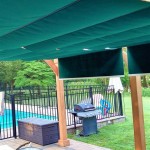Do You Have To Slope A Paver Patio? Understanding Patio Drainage and Design
The installation of a paver patio represents a significant investment in property value and outdoor living space. A crucial, yet often overlooked aspect of patio construction is proper drainage. Leaving standing water on a patio surface can lead to a multitude of problems, from aesthetic concerns like unsightly algae growth to structural issues stemming from freeze-thaw cycles. Therefore, understanding the principles of patio sloping and drainage is paramount to ensuring the longevity and functionality of the paved area.
The question of whether a paver patio requires a slope is answered with a resounding yes. Building codes often mandate a minimum slope for exterior hardscaping to facilitate water runoff. However, adherence to code is just one reason why a sloped surface is essential. Without a slope, rainwater, melting snow, and even sprinkler runoff will pool on the patio, creating slippery conditions and potentially damaging the paving materials and their underlying base.
This article will explore the reasons why sloping a paver patio is necessary, the recommended slopes and drainage methods, and the potential consequences of neglecting this vital aspect of patio design and construction. Furthermore, it will delve into considerations for different types of soil, patio sizes, and paving materials.
The Importance of Adequate Drainage
Water is a powerful force that can degrade even the most robust materials over time. In the context of a paver patio, standing water poses several threats. First and foremost, it can seep into the joints between the pavers, washing away the polymeric sand or other jointing material. This erosion weakens the interlock between the pavers, making them susceptible to shifting and settling. Over time, this can lead to an uneven and unsightly patio surface. The gaps created by eroded jointing material also provide a breeding ground for weeds and insects, further detracting from the patio's aesthetic appeal.
Secondly, standing water can promote the growth of algae, mold, and mildew. These organisms not only stain the paver surface, making it look dirty and unkempt, but they also create a slippery and potentially hazardous walking surface. Power washing can remove these growths, but it is only a temporary solution if the underlying drainage problem is not addressed.
The impact of freeze-thaw cycles on a paver patio without adequate drainage is especially destructive. When water trapped within the pavers or the underlying base freezes, it expands. This expansion exerts significant pressure on the surrounding materials, potentially causing cracks in the pavers or heaving of the entire patio surface. This damage is particularly pronounced in regions with cold winters, where repeated freeze-thaw cycles can rapidly degrade the integrity of the patio.
Beyond these direct physical effects, inadequate drainage can also lead to problems with the underlying soil. Excessive moisture can saturate the soil, reducing its load-bearing capacity. This can cause the patio to settle unevenly, creating a bumpy and unstable surface. In areas with expansive clay soils, saturation can lead to swelling, further exacerbating the problem of differential settlement. Finally, water pooling around the base of the house can seep into the foundation, potentially causing structural damage and mold growth within the home.
Recommended Slope and Drainage Methods
The industry standard for paver patio slope is a minimum of 1/8 inch per foot. This means that for every foot of patio length, the surface should drop by at least 1/8 inch. A slope of 1/4 inch per foot is often preferred, especially for larger patios or in areas with heavy rainfall. This steeper slope ensures that water flows away from the patio surface quickly and efficiently. The slope should always direct water away from the house foundation and towards a designated drainage area.
Several drainage methods can be employed to effectively manage water runoff from a paver patio. The simplest method is to slope the patio towards an open area, such as a lawn or garden bed. This allows the water to naturally disperse into the surrounding soil. However, this method may not be suitable for all properties, especially those with limited space or poorly draining soil.
For properties where natural drainage is not feasible, more sophisticated drainage solutions may be necessary. These include installing a channel drain along the edge of the patio to collect water and direct it to a storm sewer or other drainage system. Channel drains come in various sizes and materials, and they can be easily integrated into the paver patio design. Another option is to install a French drain, which consists of a perforated pipe buried in a gravel-filled trench. The French drain collects water from the patio and directs it away from the area.
Regardless of the drainage method chosen, it is crucial to ensure that the underlying base of the paver patio is properly compacted and graded. The base should consist of several inches of compacted gravel, which provides a stable and well-draining foundation for the pavers. The base should also be sloped in the same direction as the finished patio surface to ensure that water flows freely away from the pavers.
When planning the drainage for a paver patio, it is essential to consider the surrounding landscape. The patio should be designed to integrate seamlessly with the existing grade, and the drainage should not negatively impact neighboring properties. It may be necessary to consult with a landscape architect or engineer to develop a comprehensive drainage plan that addresses all of these concerns.
Consequences of Neglecting Proper Sloping and Drainage
The consequences of neglecting proper sloping and drainage can be significant and costly. As previously mentioned, standing water can damage the pavers, erode the jointing material, and promote the growth of algae and mold. These problems can detract from the aesthetic appeal of the patio and create a safety hazard. Furthermore, the freeze-thaw cycle can cause cracking and heaving, leading to costly repairs or even complete replacement of the patio.
Beyond the direct damage to the patio itself, inadequate drainage can also lead to problems with the surrounding landscape. Excessive water runoff can erode the soil, damage plants, and create muddy conditions. In severe cases, it can even lead to flooding of nearby properties. The cost of repairing these problems can be substantial, especially if structural damage to the house foundation is involved.
Correcting drainage problems after a paver patio has been installed is often more difficult and expensive than addressing them during the initial construction phase. It may be necessary to remove the pavers, regrade the base, and install new drainage systems. This can be a time-consuming and labor-intensive process, particularly for large patios. Therefore, it is always best to plan for proper drainage from the outset and avoid the potential for costly repairs down the road.
Furthermore, neglecting proper drainage can void the warranty on the pavers themselves. Most paver manufacturers specify that the pavers must be installed according to industry standards, which include proper sloping and drainage. If the pavers are damaged due to standing water or freeze-thaw cycles, the manufacturer may refuse to honor the warranty, leaving the homeowner responsible for the cost of replacement.
In addition to the financial costs, neglecting proper drainage can also lead to legal problems. If water runoff from a paver patio damages neighboring properties, the homeowner may be held liable for the cost of repairs. This can result in costly lawsuits and damage to the homeowner's reputation. Therefore, it is essential to ensure that the paver patio is designed and constructed in a way that minimizes the risk of water damage to surrounding properties.
Finally, a poorly drained patio can simply make the space unusable. Standing water, slippery surfaces, and mosquito infestations can all deter people from using the patio, ultimately defeating the purpose of the outdoor living space. By investing in proper drainage, homeowners can ensure that their paver patio remains a beautiful and functional addition to their property for years to come.
In conclusion, sloping a paver patio is not merely a suggestion but a necessity for its longevity, functionality, and safety. A properly sloped and drained patio protects the investment, prevents damage to surrounding areas, and ensures that the outdoor space remains enjoyable and usable for years to come. The initial effort and expense dedicated to proper drainage are significantly less than the cost and inconvenience of addressing drainage problems after the patio is constructed.
.jpg?strip=all)
How To Install Patio Pavers Lv
Questions On Sloping A Raised Patio Lawn Care Forum

How Much Slope Should A Paver Patio Have Roofing Contractor Nj Chimney Sweep Siding Masonry New Jersey
Building Paver Patio On Slope Pics Lawn Care Forum

Block Patio Slope Question Doityourself Com Community Forums

Laying Patio Pavers Polycor Inc

Urban Landworks Blog

Paver Installation How Important Is The Base

How To Properly Level A Patio Or Walkway
Paver Patio Slope Diy Home Improvement Forum
Related Posts








